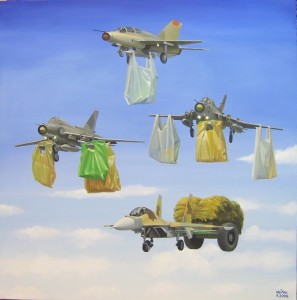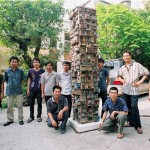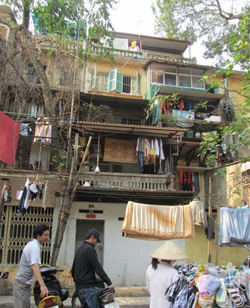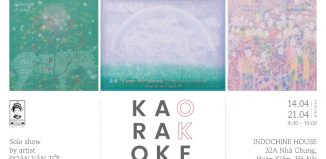KVT interviews Nguyen Manh Hung
 |  |
LIVING TOGETHER IN PARADISE…..Fact and Allusion
Nguyen Manh Hung, born 1976, spent his formative years growing up, like a lot of Hanoian kids, in one of those Soviet-style apartment blocks which he describes as being a vertical village. Great places for kids and childhood friendships.
My brief was to interview Nguyen Manh Hung… about his excursion into paradise. …his work is too full of tales and allegories for a mind such as mine and I apologize if I’ve … grabbed the wrong sabre-tooth tiger by the tail…
Places where families lived close together in shared rooms and built interior walls to enclose their privacy and tacked on overhanging additions to extend their space. Vertical villages where everyone knew everyone else’s business and where it was difficult to keep things secret.
Hung’s Dad was a fighter plane pilot and the boy was fascinated with these vehicles of war so it’s no wonder that when he became an artist they began to appear in his work and have been regular features since 2004. But Hung’s fighter planes are not spitters of death and destruction. They are benign transports of hope, help and joy. They fly above and through surrealist landscapes with their loads of good stuff attached to fuselages or in trailers they fantastically tow behind.

Some 2006 paintings, combining the fighter planes with apartment buildings topped with village scenes, give a harbinger of his present exhibition at the Goethe Institute in Hanoi (April 2011). And the sketch shows a drawing of the completed concept – a surreal vision of that childhood apartment block that has grown to be 20 floors high, and that has been shown in Oslo and Berlin.

Hung’s Dad was a fighter plane pilot and the boy was fascinated with these vehicles of war…

With the assistance of friends from his years at the Fine Arts University, Dang Quoc An, Vu Xuan Dong and Nguyen Trung Chinh, the model was cut from MDF composite board using a template and a computer programmed cutting tool.

They painted it and then made and attached to it, in exact scale, exterior fixtures, illegal add-ons and the expected adornments such as washing hanging out to dry. Seen from up close the building is a wonder of intricate and accurate detail. A video of the construction process at the exhibition captures a lot of prolonged attention.
Upon the return of the model to Hanoi, Hung used his very fertile and super-surreal imagination to re-conceptualize.
During an exhibition in the US, he’d been super impressed with that famous diorama at the Museum of Natural History in New York of a mammoth being attacked by sabre-tooth tigers. The concept of a diorama installation became a focus for a new presentation of the apartment block tower. The gallery space at Goethe was tall enough to build a scene that could be looked into from an elevated viewing platform.
Upon entering the gallery you see steps leading up to the platform and you catch a tantalizing view of the tower top peeking into a deep blue sky spun with cirrus clouds.

When you ascend the stairs you look down at the three meter building soaring through a dense stratocumulus layer. Some of its interior lights are ablaze and you almost expect to see inhabitants going about their daily lives.
Hung’s influence on the generation of Vietnamese artists who come after him is quite profound.
Hung has made this the viewing angle as he wants you to take in the rural village scene that is constructed on the roof. Most of Hung’s paintings are set in a rural landscape, perhaps to reinforce his view that the elements of village tradition and agriculture are still at play and are important factors, even in the lives of urban, vertical village dwellers.
Then you spy the fighter plane to one side of the scene, dwarfed by the tower and zooming in an arc, small bundles of hay in its missile launchers, and trails of white vapor spuming behind. (The director of the Goethe Institute likens them to fine sprays of whipped cream.)

The scene immediately brought to mind a poem that I loved and committed to memory in secondary school. ‘High Flight’ by John Magee, a World War 2 fighter pilot, wrote it after learning to fly and skip through clouds:
‘Oh! I have slipped the surly bonds of earth,
And danced the skies on laughter-silvered wings;
Sunward I’ve climbed, and joined the tumbling mirth
Of sun-split clouds, –and done a hundred things
You have not dreamed of –Wheeled and soared and swung
High in the sunlit silence. Hov’ring there
I’ve chased the shouting wind along, and flung
My eager craft through footless halls of air…
Up, up the long, delirious, burning blue
I’ve topped the wind-swept heights with easy grace
Where never lark or even eagle flew —
And, while with silent lifting mind I’ve trod
The high untrespassed sanctity of space,
Put out my hand, and touched the face of God.’
And it’s on the first and last three lines that I hang this interpretation of Nguyen Manh Hung’s intent in his arresting installation.

Hung has called the exhibition ‘Living Together in Paradise’ and initially the viewer may be taken aback as few would associate living in a cramped space in an aged tenement as a taste of paradise. Probably you’d think of them wanting to fling off the bonds and opt for an apartment in a modern high rise or something with a high security wall and small garden. However someone who has grown up and grown old and dependent on the village ethos that is often afforded by the crowded apartment block may well consider it a perfect slice of heaven on earth. And for such a person, the afterlife could resemble a cosmic representation of the same brick and concrete structure, complete with convivial village atmosphere, though populated with those ancestors and relatives who will make eternity a blissful place.
The apartment complex rises into the stratosphere, above all earthly concerns, a permanent abode for immortal souls where they can forever, even casually, reach out and brush the face of God.
Many mortals who aren’t committed atheists will have a similar view of their heaven as being replicas of the familiar, albeit much more carefree. In the case of the Vietnamese village dweller, this paradise probably hovers not too far above those they leave behind. From where they can occasionally be called down to the family altar, and from whence they can receive those wonderful offerings sent to them in wisps of smoke by the earthbound. Also, a place where they can peer down from their stratospherical balconies and keep a benevolent watch on their descendents.
This sacrosanct paradise can only be accessed by the dead but it can be occasionally invaded by mere mortals who have the technological powers to fly through its lower reaches in specially designed airplanes or float its blacker heights in space craft. Unless these aliens have attained the insight of the poet, Magee, they will not recognize that they are passing through paradise.
He was super impressed with that famous diorama at the Museum of Natural History in New York of a mammoth being attacked by sabre-tooth tigers…
You, as the participant on the viewing platform, can see yourself as one of the gods looking down at divine creation (though the ancient Greeks knew the hubris this may entail). I was there as a diviner of the tales and allusions laid down purposefully, metaphorically and unintentionally by the artist. All of us who climb those steps become participants, integral components in the installation.
I asked Hung if he’d envision installing the model in a non-diorama format, say using a whole gallery space to create paradise. He had no problem with the concept but said that he’d need to construct more towers so that viewers could wander around them as giants in a surreal scenario. He’s used this device in earlier paintings.

The vertical villages of Hung’s youth are mammoths of Hanoian architecture, gradually being brought to their overburdened, concrete knees by jack hammers – the sabre-tooth tigers of Hanoi’s urban development. It is apt that Hung’s song of praise honours their place in historical time.
Hung has no problem if some label him cinematic. Though he has a surrealist approach he has no favourite artists from that movement. When he mentions Edward Hopper as a painter whose work he admires, you can see parallel echoes.
Hung’s influence on the generation of Vietnamese artists who come after him is quite profound and it is interesting to see how aspects of his style have been appropriated. I won’t start naming in case I become embroiled in arguments. In any case, unless it’s flamboyant plagiarism, I can’t see much wrong with a little borrowing from brilliance.
Come May, Hung will marry and relocate to Saigon. One wonders if this will influence the imagery in his art practice, imagery that is redolent of the red River Delta and its age-old villages.
My brief was to interview Nguyen Manh Hung and to write a factual report about his excursion into paradise. Unfortunately his work is too full of tales and allegories for a mind such as mine and I apologize if I’ve run away on too many tangents or grabbed the wrong sabre-tooth tiger by the tail. I’ve deliberately left out my wild conspiracy theory and my Guinness Book of World Records concoction… but would love to meet up with other lateral thinkers and chew over the ironic twists in the title.
FOOTNOTE
Thanks to Hung for letting us use images of his work from his website. See more of Hung’s work on his website … do a slideshow through the pictures to the end at image 51 and to see more of his fighter planes. At the same time go back and enjoy other work that he’s done, mostly in his clever and ironically humorous, surrealist style. Continue to the exhibition of the apartment block model in Norway…..after that, reverse to catch some wonderful images of another fighter plane that was initially destined to incinerate.
![]()
| Not a reviewer, not a critic, “Kiếm Văn Tìm” is an interested, impartial and informed observer and connoisseur of the Hanoi art scene who offers highly opinionated remarks and is part of the long and venerable tradition of anonymous correspondents. Please add your thoughts in the comment field below. |

















Hi — I loved this piece, thanks, but FYI the link doesn’t work now:
http://hung6776.multiply.com/photos
Thanks to Hung for letting us use images of his work from his website. See more of Hung’s work on his website …
Hi Brenda, the interview was written in 2011 and recently multiply has just closed down. I’ll ask Hung if he’s got a new website.
Thanks for the comment!
Hung’s new website is : http://hung6776.com/